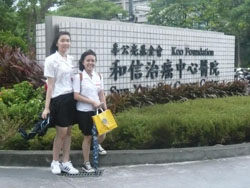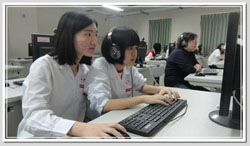Project Overview
1. Description of Our Community
Our community, Kaohsiung City is located in southern Taiwan. Kaohsiung , a glamorous and modern metropolis is the second largest city of this island. There are roughly 2270 thousand people living in this city, along with thirty eight districts. Situating between Cijin Island and downtown, port of Kaohsiung is the world-class port in Taiwan as well as a hub for international trade. Taiwan is a shared community with high medical quality. Under such circumstances, the government implemented the health insurance system. Besides, we have well-formed education system. We are proceeding to twelve-year compulsory education. Our higher education is aimed at cultivating professionals. And the medical education has achieved the high academic levels.
2. Summary of Our Project
We strive to dig into Taiwan's medical environment after seeing many reports pertaining to medical circumstances via the media. In the beginning, we did lots of studies. Then, we determined to focus on Andrew T. Huang, the director of Sun Yat-Sen Cancer Center. Afterwards, part of our teammates interviewed Andrew T. Huang on Aug.24 2012. We transcribed our interview so as to acquire more. In addition, we discussed and made our own comments on Dr. Huang's opinions, both physically and virtually on the Skype. Furthermore, we used the social media, such as Facebook to advocate our project and hoped to be known by more citizens. On Dec.14 2012, we entered a proposal hearing of the humanity program of National Science Council in front of several professors and numerous students. In consequence, we got lots of feedback from this meeting.
3. Our Computer and Internet Access
A. Percentage of students using the Internet at home: more than 50%
B. Number of workstations with Internet access in the classroom: more than 6
C. Connection speed used in the classroom: dedicated connection
D. Number of years our classroom has been connected to the Internet: more than 6
E. Additional comments concerning your computer and/or Internet access (Optional):
Taiwan schools are located on TANet Network(academic connection). In southern Taiwan, there will be a bit difficulty connecting abroad. But we are figuring out ways to improve the connection.
4. Problems We Had to Overcome
While we are doing the CyberFair project, we encounter a huge problem that we can hardly get photos from Dr. Huang because he is always busy working and often flies between U.S. and Taiwan. Because Dr. Huang is always occupied, it takes us a lot of time to wait for the interview with Dr. Huang and his partners. Besides we have to find verified source publication. The process was very tedious, and the publisher was going to charge us at the very beginning. It is hard for us to get permission from the publisher. However, we get through it.
5. Our Project Sound Bite
Recently in Taiwan, there is a very import person who has done a lot of amazing things trying making a difference in our medical system. Our project will tell you about and what Andrew T. Huang has done and how he persists in pursuing the dream. There are so many things that people can learn from him. After taking part in International Schools CyberFair, it made us feel happy that we can share the information with people from all over the world. We are very glad to know that people from around the world are actually getting better knowledge of the project we have been working on. It is very exciting for us to know that our voices have been heard.
6. How did your activities and research for this International Schools CyberFair project support content standards, required coursework and curriculum requirements?
Under the Exam-oriented educational environment, project-based learning is never easy because we have to achieve a good time management. But our class join humanities-specialized program of National Science Council, we have more advantage of being exposed to different disciplines. Engaged in the classes of the humanity social science, we hope that schools do not lay special emphasis on academic knowledge, but pay more attention to the concern about people. If so, students will recall the concept that all the human beings do is aimed to make people live better. Based on this thought, we started to do the project. At the initial stage of the project work, we sometimes thought differently and clashed with one another. But we tried to respect other’s rights to speak, and tolerate other’s comments while discussing ideas, whether we were online or face to face. While we were brainstorming, our teacher taught us how to define a thing by integrating anything about it and giving a definition. Because everything was working like that, plus we had learned to search for information via the Internet and books, and integrate everything what we found. We came up with a lot of great ideas. Based on first-hand interview contents, including Dr. Huang's and his partner's narrative transcriptions, verified source publications and copyrighted photos and materials, we construct a website.




